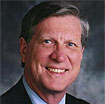About ten years ago, I was wandering down a side street in Seoul, Korea, when I stumbled across a tiny theological bookstore jammed in between a noodle shop and a fruit and vegetable stand.
Even viewed through the dusty storefront window, this unlikely place looked interesting, books new and used spilling off of shelves and onto stacks piled up on the floor. Curious, I went inside. I don’t read Korean, but some titles on the shelves were unmistakable: Barth’s Romans, Moltmann’s Theology of Hope, and Tillich’s Systematic Theology among them. Tucked over in a corner was a section of volumes that was clearly homiletics, mostly Korean authors whom I did not recognize. But at eye level was a whole shelf filled with a single title, a dozen copies or more of Eugene Lowry’s The Homiletical Plot.
This book was obviously a hot commodity in Korea, and standing there, thousands of miles from home, I was reminded of the widespread and enduring impact of Eugene Lowry’s work in preaching, especially the “big idea” Lowry advanced so persuasively in The Homiletical Plot. First published in 1980, The Homiletical Plot is still in print (now in an expanded edition) over a quarter of a century later, a track record for staying power and popularity in our consumer culture perhaps matched only by the Rolling Stone
Lowry’s “big idea,” as is now well known, was to think of the sermon in its essential form as “a premeditated plot which has as its key ingredient a sensed discrepancy, a homiletical bind.”1 In short, Lowry was claiming that sermons, like old time Westerns, don’t really get going until trouble comes to town. When listeners smell trouble in the air (the “sensed discrepancy”), they will enter a state of restless ambiguity and will have a powerful desire to see this ambiguity resolved, which can happen only when they call upon the capacity of narrative to repair the gap and to see that the trouble is satisfactorily addressed.
By seeing sermons this way–as processes for addressing ambiguity in hearers–Lowry was, with a single stroke, able to score two homiletical goals. The first was to summon the sermon away from bland abstraction. The first task of the sermon is to evoke (or perhaps to provoke) the kind of trouble that listeners would recognize as urgent and real. Lowry sniffed, for example, at sermons on Joshua 24:15 that dramatically challenge listeners to “choose this day whom you will serve, God or Baal!” God or Baal? This is not the choice, this is not the conflict as people perceive it, as real people live it, argued Lowry.
People are not caught between a generalized good and a generalized bad. They are caught in the bind of two quite specific goods or two specific bads–or (perhaps more likely) among several options, none of which is good or bad….The homiletical plot must catch people in the depths of the awful discrepancies of their world–social and personal. It is to these very real discrepancies that the gospel of Jesus Christ is addressed.2
Lowry’s second achievement, and this is the one for which he is justly celebrated, was to realize that ambiguity at the beginning of a sermon is best resolved through a plotted sermon, a sermon with a narrative-like process, a developmental sequence of existentially oriented steps. In doing so, he challenged all static models of sermon design. Sermons don’t have structures; they are events unfolding temporally. “Because,” he said, “a sermon is an event in time–existing in time, not space–a process and not a collection of parts, it is helpful to think of a sequence rather than a structure.”3
Lowry prescribed a five-fold plot sequence. The sermon (1) begins with a salvo of conflict and tension, which upsets the listeners’ equilibrium and pushes the plot downward; (2) analyzes the conflict, which keeps the plot plummeting; (3) draws upon the gospel to disclose the clue that will ultimately resolve the conflict, an epiphany that precipitates a sudden reversal and causes the plot to loop upward; (4) elaborates the clue to resolution in ways that cause the listeners to experience of the gospel and that keep the plot moving upward; and finally 5) builds upon the resolved conflict to anticipate the future, basically ethical, trajectory of the sermon in the lives of the listeners.
Because this master sermon design contains a roller coaster–like reversed circuit in the middle, it garnered the nickname “the Lowry loop,” but what we actually have here is a schematic diagram for an Aristotelian tragic-comedy. The sermon is plotlike in the sense that it flows from “itch to scratch,” as Lowry liked to put it.4 The plot action descends steadily until the denouement, at which point it reverses course and is constituted by an unremitting rising action.
1Eugene L. Lowry, The Homiletical Plot: The Sermon as Narrative Art Form, exp. ed. (Louisville: Westminster John Knox Press, 2001), 20.
2Ibid.,25.
3Ibid.,26.
4Ibid.,23.
Excerpted with permission from: What’s the Shape of Narrative Preaching? (Copyright) 2008 Chalice Press.
Order What’s the Shape of Narrative Preaching? at 25% off from the Luther Seminary Bookstore.

